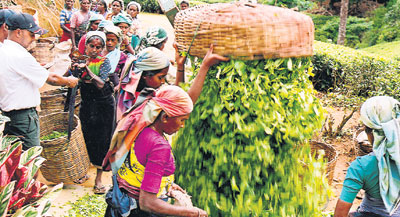
National poverty levels decliningHowever, this does not mean districts are well off- Researcher
The main contributor to the drop of the national poverty level to 15.2 percent in 2006/07 from 22.7 percent in 2002 is the decrease of poverty incidence in the rural sector to 15.7 percent in 2006/07 from 24.7 percent in 2002, officials involved in the study of poverty say. The rural sector is significant as 80 percent of the population of Sri Lanka falls under that category. However, poverty in the estate sector which holds about 5.5 percent of the population of the country has reached a new high to 32 percent in 2006/07 from 30 percent in 2002, indicating that almost 1 in every 3 persons suffers from poverty. The continuous drop of poverty throughout the last two decades in the urban sector has been matched by the highly urbanized Western province in which above 60 percent of the urban population in Sri Lanka lives. Director General of the Department of Census and Statistics (DCS), Suranjana Vidyaratne said the official poverty line which is the minimum expenditure per person per month to fulfill basic needs, has been calculated at Rs.2233 which includes real total food and non-food expenditure per month per capita. In 2002, the official poverty line was calculated at Rs.1423. Addressing a discussion on trends in poverty organized by the Centre for Poverty Analysis (CEPA) this past week, Vidyaratne said the 2006/07 Household Income and Expenditure Survey (HIES) conducted by the DCS shows poverty levels declined in most districts with the exception of Nuwara Eliya in which poverty increased to 33.8 percent in 2006/07 from 22.6 percent in 2002. CEPA's Senior Professional on Poverty and Impact Monitoring Neranjana Gunathileke said that there are no surprises in terms of national trends that poverty has been decreasing. Gunathileke did say that it is surprising that all districts showed a decrease in poverty except Nuwara Eliya which showed a sharp increase which could be related to policy decisions which are either facilitating or constraining poverty. Gunathileke pointed out that the Colombo and Gampaha districts, the lowest poverty districts in the country at 5.4 percent and 8.7 percent respectively are pushing down the level of poverty in the urban sector. However, poverty has reduced very slightly in the two districts, by 1 and 2 percent which brings up the issue of urban poverty. In terms of the population in Colombo and Gampaha, Gunathileke said it was a serious situation and that much more research and knowledge should go into urban poverty. Estates have always been the outlier in data which shows that poverty levels are going against the trend of the rest of the country by increasing in this sector. Gunathileke said estates have always been identified as having a large concentration of poor and given the huge investments in social programs, more research is required to ascertain why progress has not been made. She added that rubber prices have been fairly good and tea has not been that bad to justify such as increase in poverty. The current policy focus may not be sufficient or may not be in line with the problems faced by the estate sector. Poverty levels in Kurunegala, Polonnaruwa and Kegalle in 2006/07 are 15.4 percent, 12.7 percent and 21.1 percent respectively, having fallen by approximately 10 percent from the 2002 figures. Gunathileke said the numbers of Kurunegala and Polonnaruwa are not surprising as the districts are economically diverse. Kegalle however is a district that has had widespread poverty but its decline could be explained by the rubber sector having performed well. The Puttalam, Hambantota and Badulla districts which had very high levels of poverty have fallen by a large percentage to 13.1 percent, 12.7 percent and 23.7 percent respectively. Gunathileke said Hambantota had been stagnant at high levels of poverty so it is difficult to understand its current level. One reason for the decrease could be the 'tsunami argument' that even if livelihood and incomes are not increasing, consumption was increasing because there was a high level of consumption coming in. There might have also been a backwash effect of construction with large numbers migrating for construction. However, only 5 percent of the DS divisions in Hambantota were affected by the tsunami which may not explain the fall in poverty levels in the district to such an extent. Members of households might be remitting cash from abroad or working in the more prosperous districts in the country leading to increased consumption. She explained that falling poverty figures does not indicate that districts are doing fine. |
|
||||||
| || Front
Page | News
| Editorial
| Columns
| Sports
| Plus
| Financial
Times | International
| Mirror
| TV
Times | Funday Times || |
| |
Reproduction of articles permitted when used without any alterations to contents and a link to the source page.
|
© Copyright
2008 | Wijeya
Newspapers Ltd.Colombo. Sri Lanka. All Rights Reserved. |
